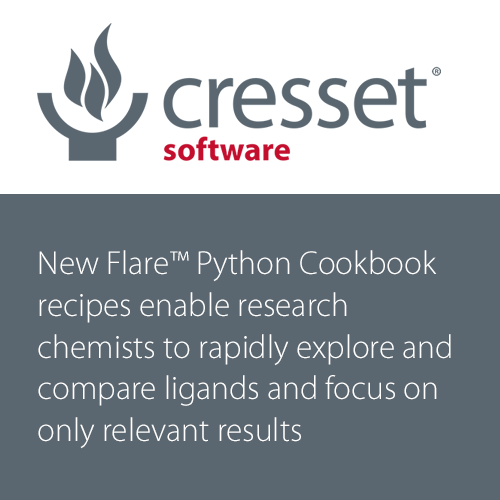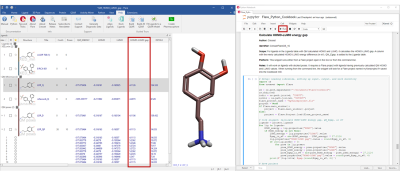New Flare™ Python Cookbook recipes enable research chemists to rapidly explore and compare ligands and focus on only relevant results

The Flare Python Cookbook is a compilation of ready-to-use recipes that make Flare Python API coding accessible to novice Python users. Each recipe, or snippet, performs a specific task and can be run directly from the Flare GUI. Computational chemists and medicinal chemists can use these simple, but fully functional, recipes on their own or as building blocks for creating more advance customized workflows.
The new recipes in the Flare Python Cookbook enable you to:
- Focus on just the results that are relevant for your project by splitting a multi-molecule SDF file into individual one-molecule SDF files
- Quickly explore ligand properties by limiting the number of conformations and/or alignments during a conformation hunt and alignment experiment
- Rapidly compare across ligands by calculating the HOMO-LUMO gap of your ligands
As an example, the CressetFlareCB_16 snippet (Figure 1) checks whether the ligands in the Flare Ligands table have any Quantum Mechanics (QM) results, previously created by a QM experiment. If they do, for each ligand the snippet finds the HOMO and LUMO energies creating a new ‘HOMO-LUMO gap’ column in the Ligands table reporting the HOMO-LUMO energy gap value. If a ligand has poses with QM results, from a previous QM pose minimization experiment, the snippet will report the HOMO-LUMO gap for each individual pose. If no QM results are found for a ligand or pose, no value will be displayed in the ‘HOMO-LUMO gap’ column.

Figure 1. Calculating the QM HOMO-LUMO gap using the CressetFlareCB_16 snippet from the Flare Python Cookbook.
The Flare Python Cookbook is created as a Jupyter Notebook which can be downloaded from GitLab.
New recipes featuring additional functionality will be available in future releases of the Flare Python Cookbook. In the meantime, if you would like a new recipe please contact Cresset support.
Request an evaluation to see how you can work more efficiently
See how you can work more efficiently by requesting an evaluation of Flare to try the Flare Python Cookbook scripts on your project.





















